Girlhood
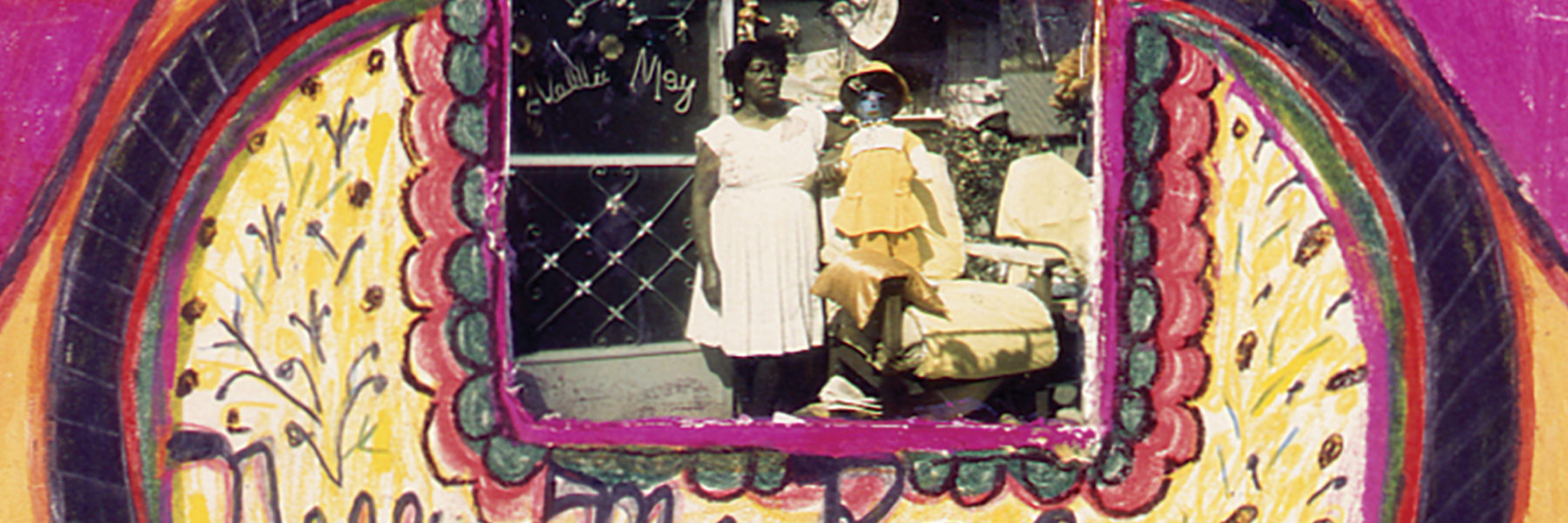
Nellie Mae Rowe (American, 1900–1982), Real Girl (detail), 1980, color photograph, crayon, pen, and pencil on cardboard, 14 × 11 inches, gift of Judith Alexander, 2003.212.
By Destinee Filmore
Nellie Mae Rowe recognized how childhood represents a state of freedom, exploration, and creative production that she was unable to enjoy as a girl and throughout most of her adult life. “I had to work so hard when I was a child,” she said. “When I could have been learning how to draw, I had to go to the field. I didn’t have the chance people have now. Children learn things.”
Rowe demanded something that children born in subsequent generations or with different socioeconomic and racial backgrounds were given more readily—the space to play and revel in girlhood. All of her art was the product of this personal rebellion, and the works in this section demonstrate how girlhood—and everything that came after—was also a central theme in her art.
Rowe bridged imagery and experiences from her childhood, including the animals who were part of her life in Fayetteville, with her desires and interests as a woman. She captured girls and women at all stages of life, depicting them with shy smiles, timid stances, and sometimes ill-fitting dresses, visualizing the awkward uneasiness that many experience during their transition from childhood to adulthood. The space she created for her female subjects, many of whom were variations of herself, reflected the values of a new generation of Black feminists who raised their voices while Rowe was making her art. Although there is no evidence that she read the writings of figures like Audre Lorde or Alice Walker, her reclamation of a deprived girlhood and elevation of women within her art was a boldly feminist act.
Citation
Filmore, Destinee. Really Free: The Radical Art of Nellie Mae Rowe, wall text. High Museum of Art, Atlanta, September 3 2021–January 9, 2022. https://link.rowe.high.org/essay/girlhood/.
“I had to work so hard when I was a child. When I could have been learning how to draw, I had to go to the field. I didn’t have the chance people have now. Children learn things.”
-
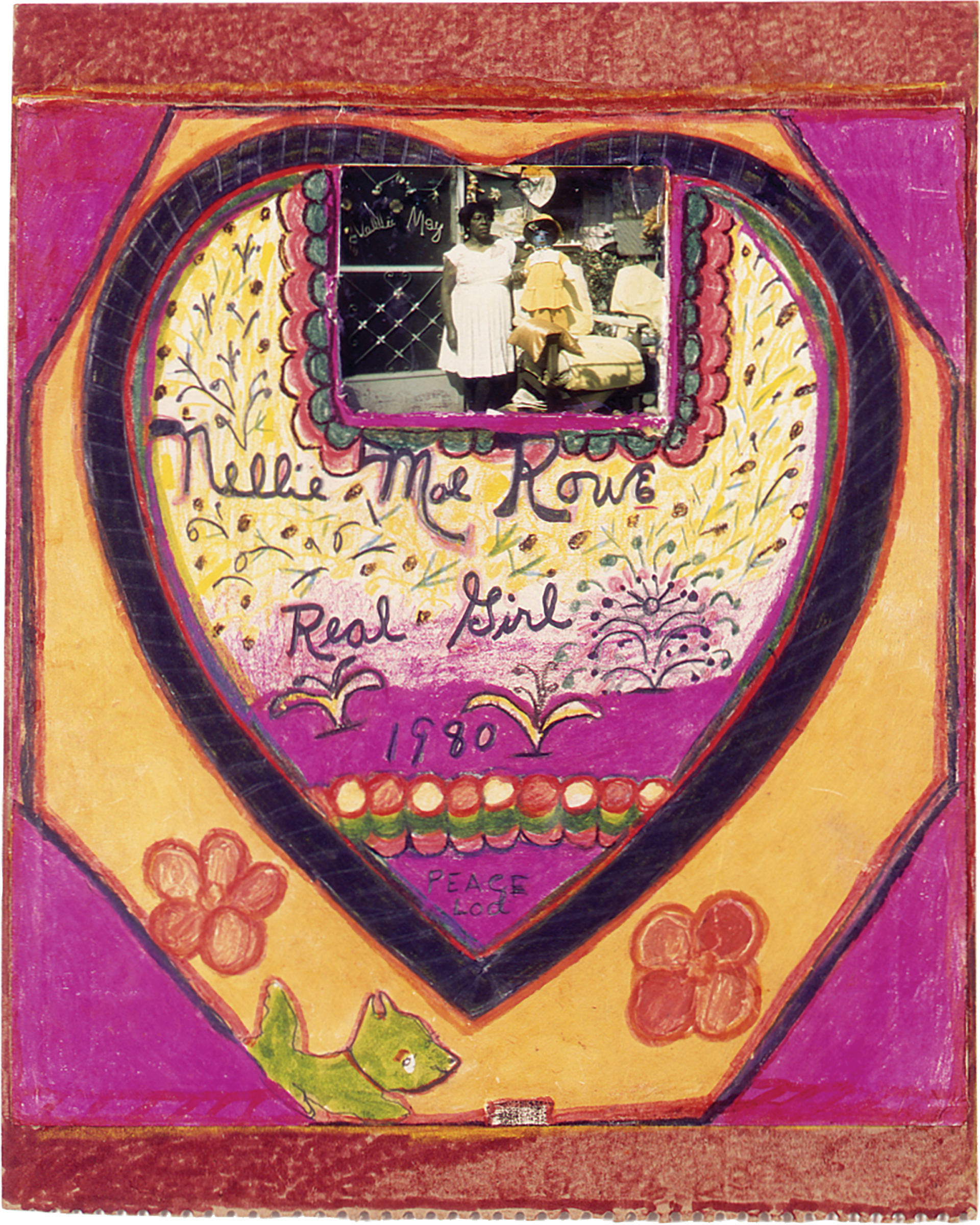
Real Girl is one of at least a dozen drawings in which Rowe embedded a picture of herself, embracing various visible dimensions of her identity and their intersections. As she told one reporter in 1979, “I am black and I love my blackness.” Here, she has placed her signature at the literal heart of her composition under an image of herself in front of her home holding a doll. She asserts that she is a “real girl” and uses traditionally feminine forms like the color bright pink, lacy edges, flowers, and the heart arabesque to complete this valentine to herself.
Real Girl
Nellie Mae Rowe, American, 1900–1982
1980
Color photograph, crayon, pen, and pencil on cardboard
14 x 11 inches
Gift of Judith Alexander
2003.212 -
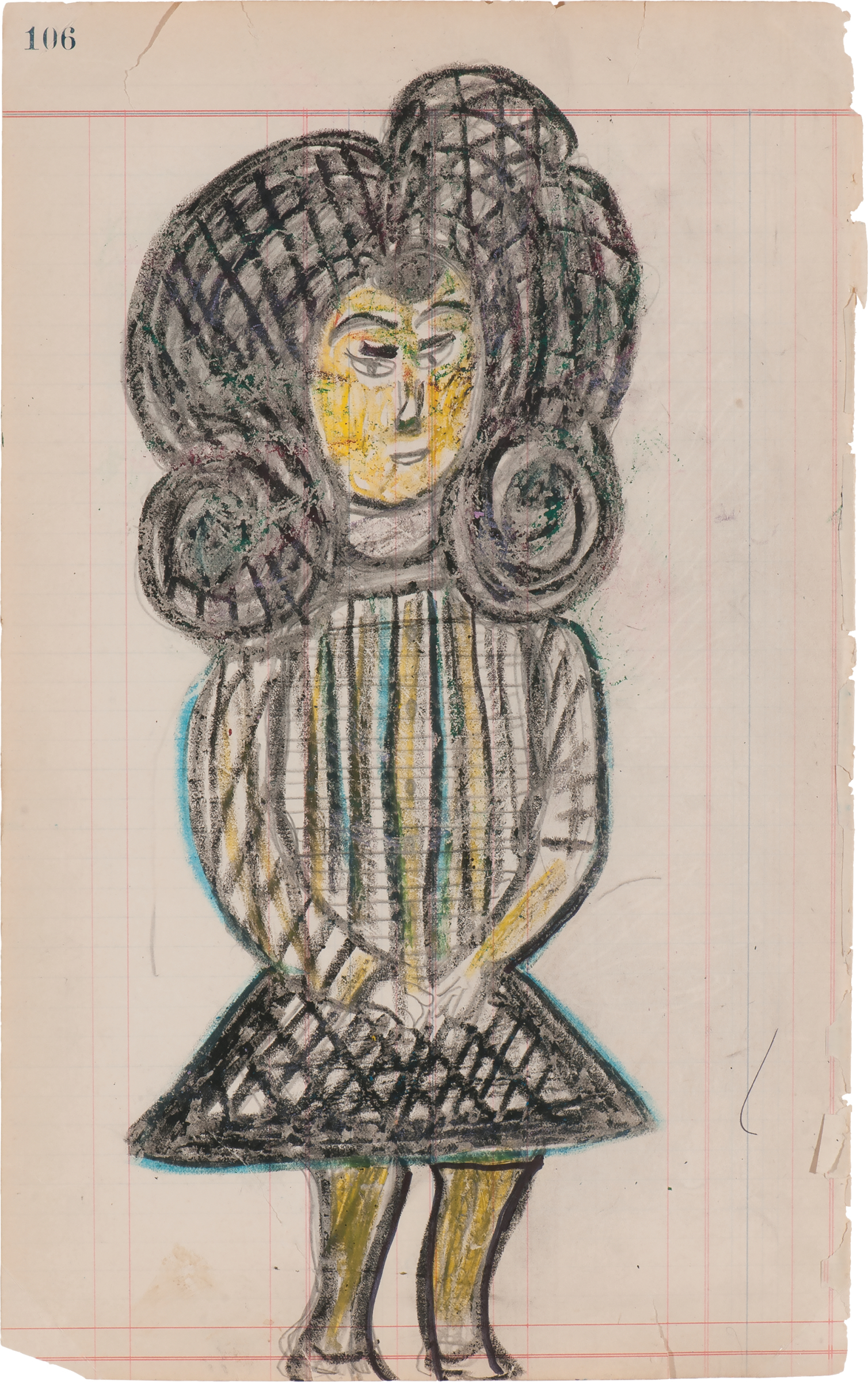
This group of work represents Nellie Mae Rowe’s compulsion to depict women and girls of varying ages, lifestyles, and states of being. The three drawings sharing a frame are on paper from the same ledger book and seem visually related: the figures are all adorned with colorful dresses (some with vertical stripes that mirror the paper’s lines), have voluminous hair or head coverings, and wear smiles that range from timid to giddy. In Untitled (Girl in White Socks) and Untitled (Woman in Chair), Rowe contends with issues of age: the young girl glows with energetic orange skin and a bright, perfectly matched green and white outfit, while the seated woman’s skin and clothing are comparatively drained of color, her gray pallor accentuating her exhaustion. This could be seen as commentary on the toll that life as a woman takes on one’s personal essence. Rowe elevates these experiences by drawing decorative frames around some of her subjects, connecting with a larger history of portraiture and challenging it by depicting herself and others with an empathy informed by her own identity as a Black, Southern woman.
Untitled (Woman with Curly Hair)
Nellie Mae Rowe, American, 1900–1982
before 1978
Crayon and pencil on ledger paper
14 x 9 inches
Gift of Judith Alexander
2003.306 -
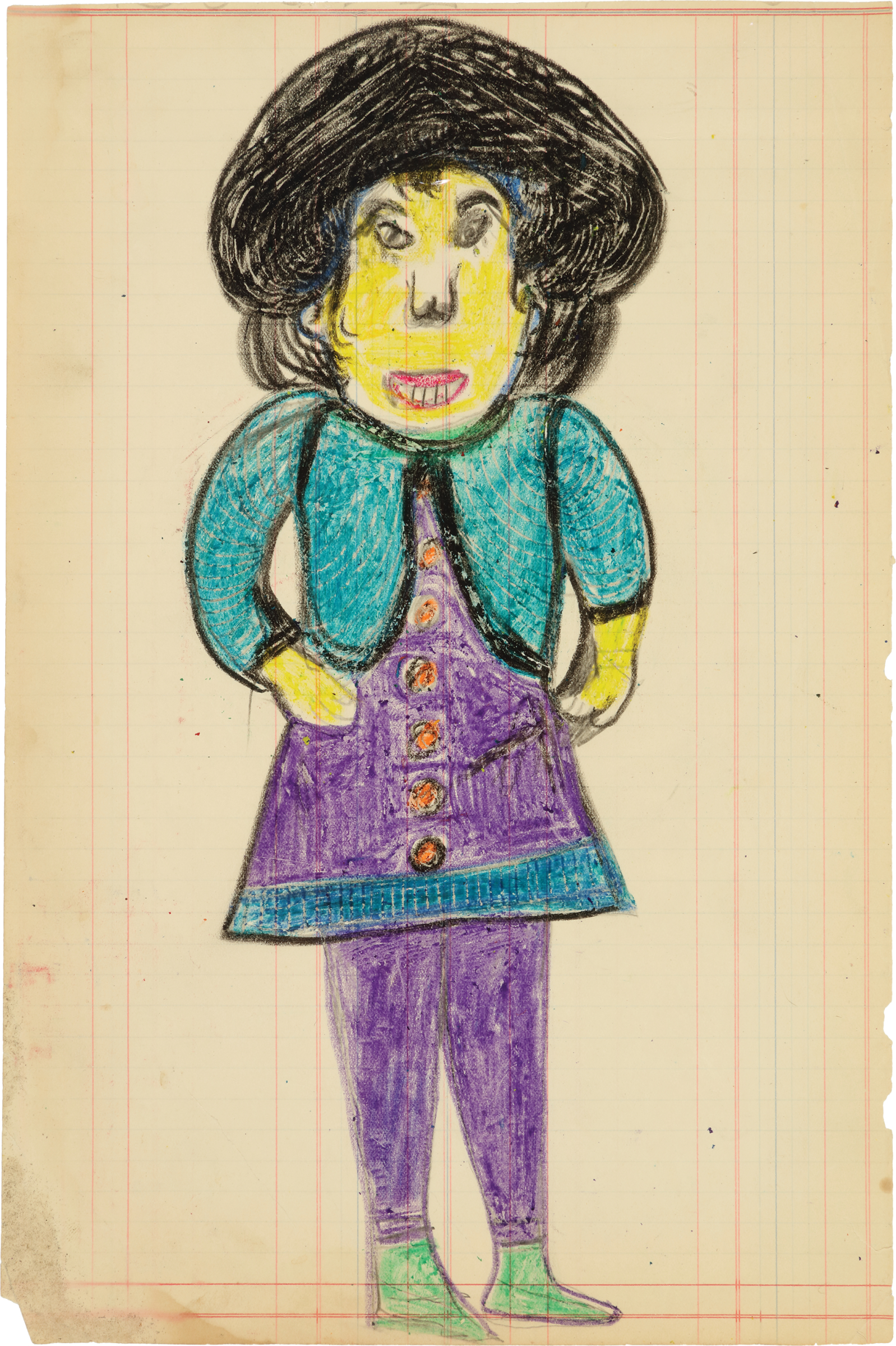
Untitled (Woman in Purple)
Nellie Mae Rowe, American, 1900–1982
before 1978
Crayon and pencil on ledger paper
14 x 9 inches; Framed with 81
Gift of Judith Alexander
2003.307 -
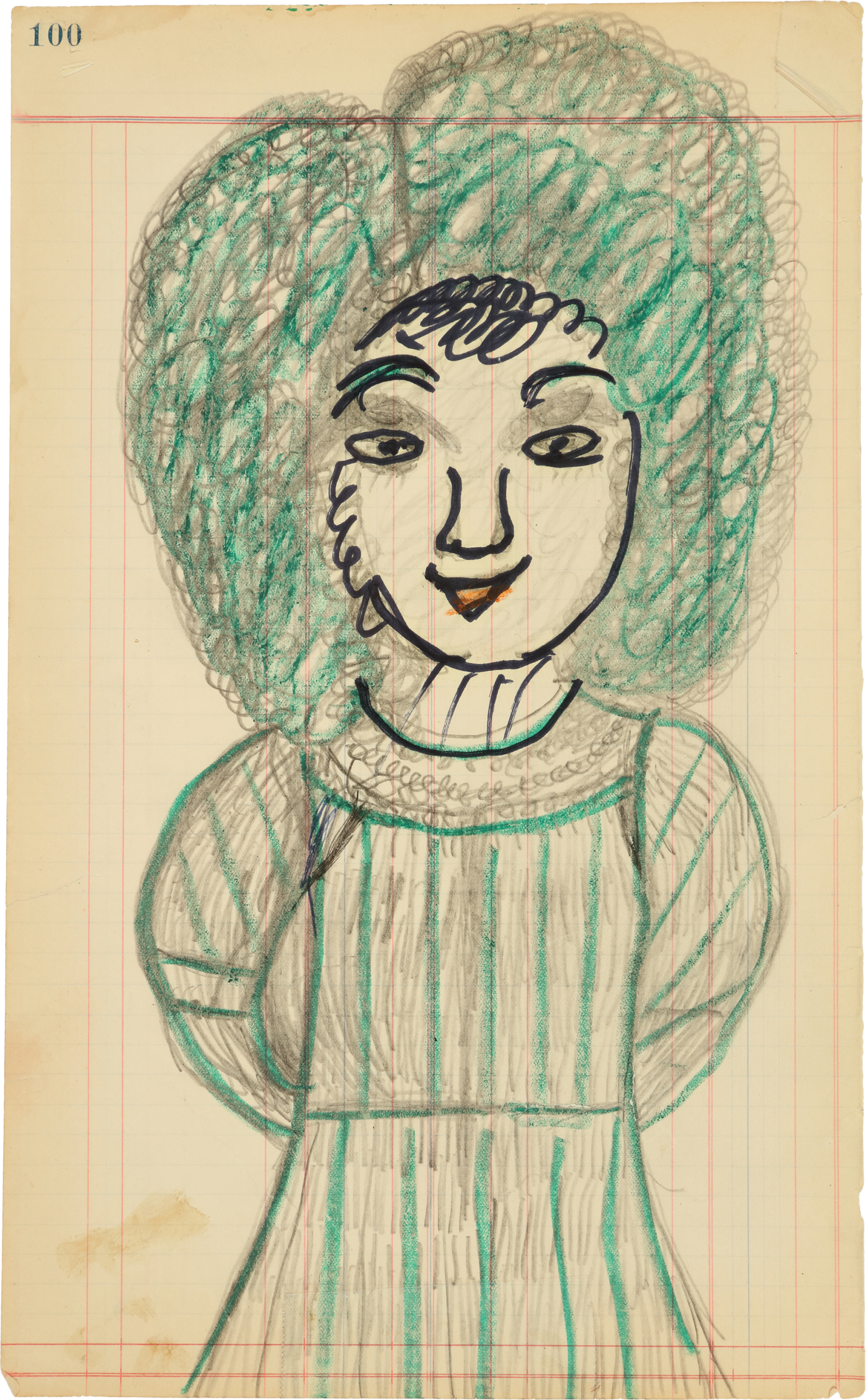
Untitled (Woman with Green Hair)
Nellie Mae Rowe, American, 1900–1982
before 1978
Crayon, pencil, and marker on ledger paper
14 x 9 inches; framed with 81
Gift of Judith Alexander
2003.308 -
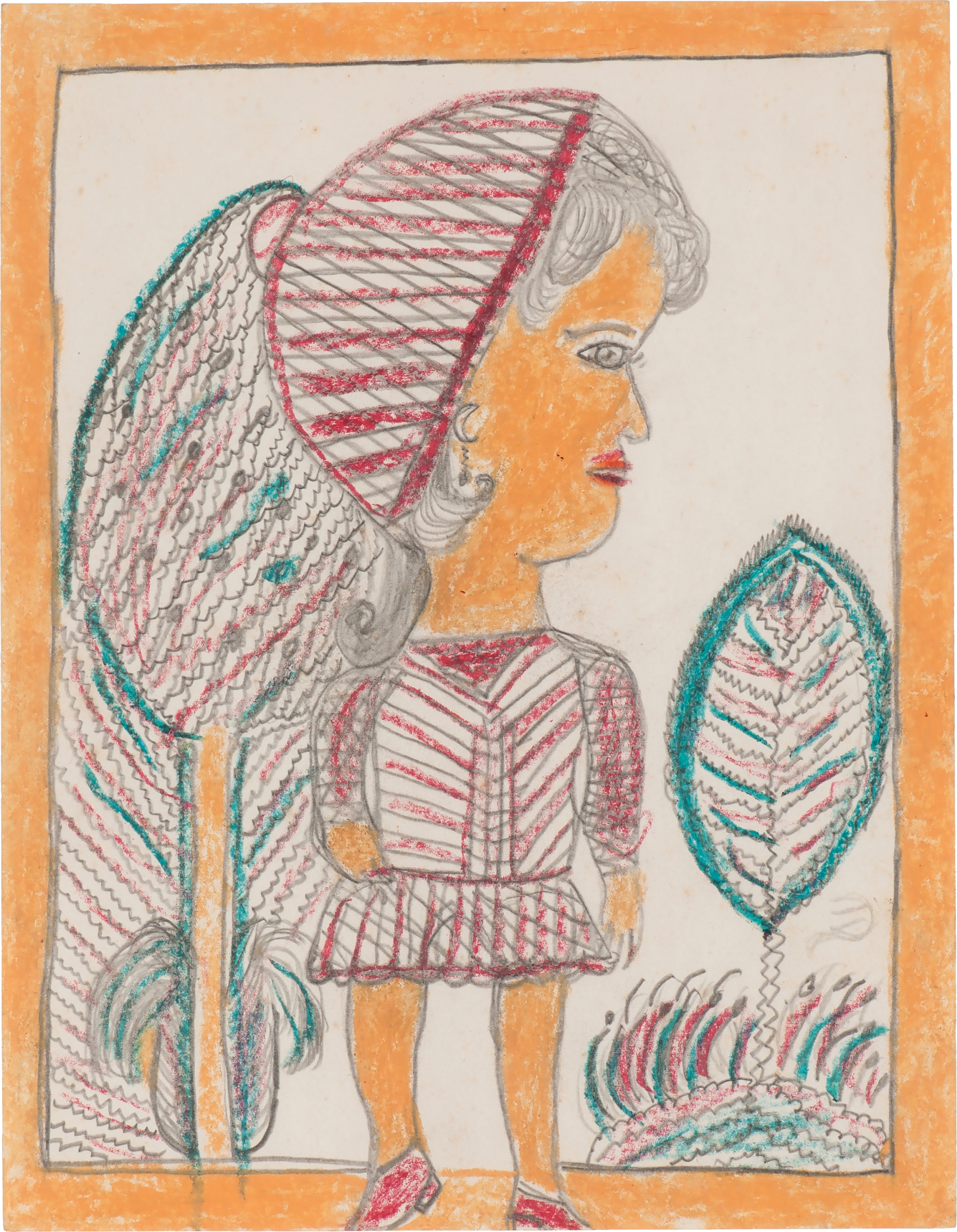
Untitled (Woman with Tree)
Nellie Mae Rowe, American, 1900–1982
1968–1982
Crayon and pencil on paper
11 x 8 1/2 inches
Gift of Andy Nasisse for the Nasisse Collection
1993.54 -
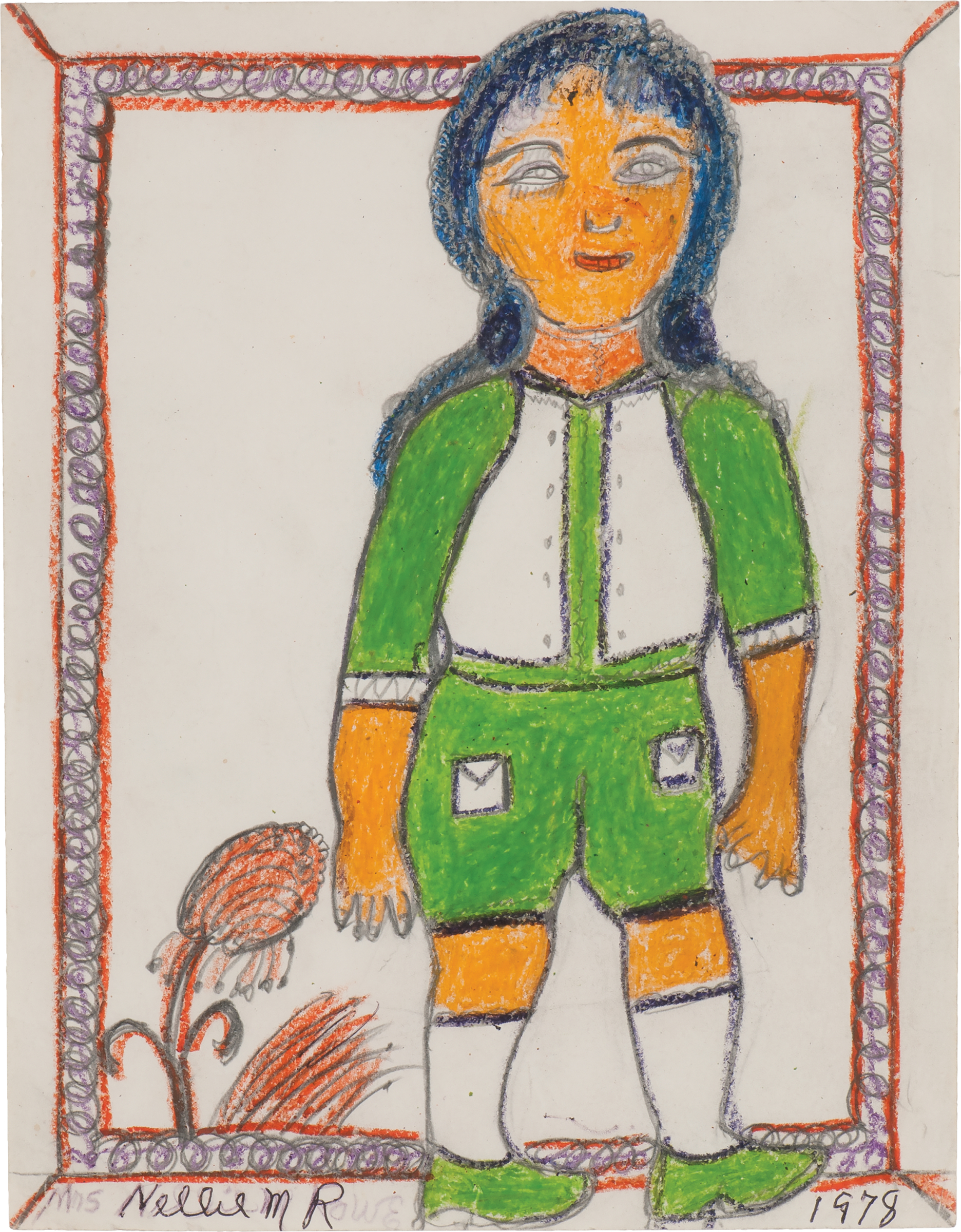
Untitled (Girl in White Socks)
Nellie Mae Rowe, American, 1900–1982
1978
Crayon and pencil on paper
11 x 8 1/2 inches
Gift of Judith Alexander
2003.181 -

Untitled (Woman in Chair)
Nellie Mae Rowe, American, 1900–1982
1968–1982
Crayon and pencil on paper
11 x 8 1/2 inches
Gift of Judith Alexander
2003.182 -
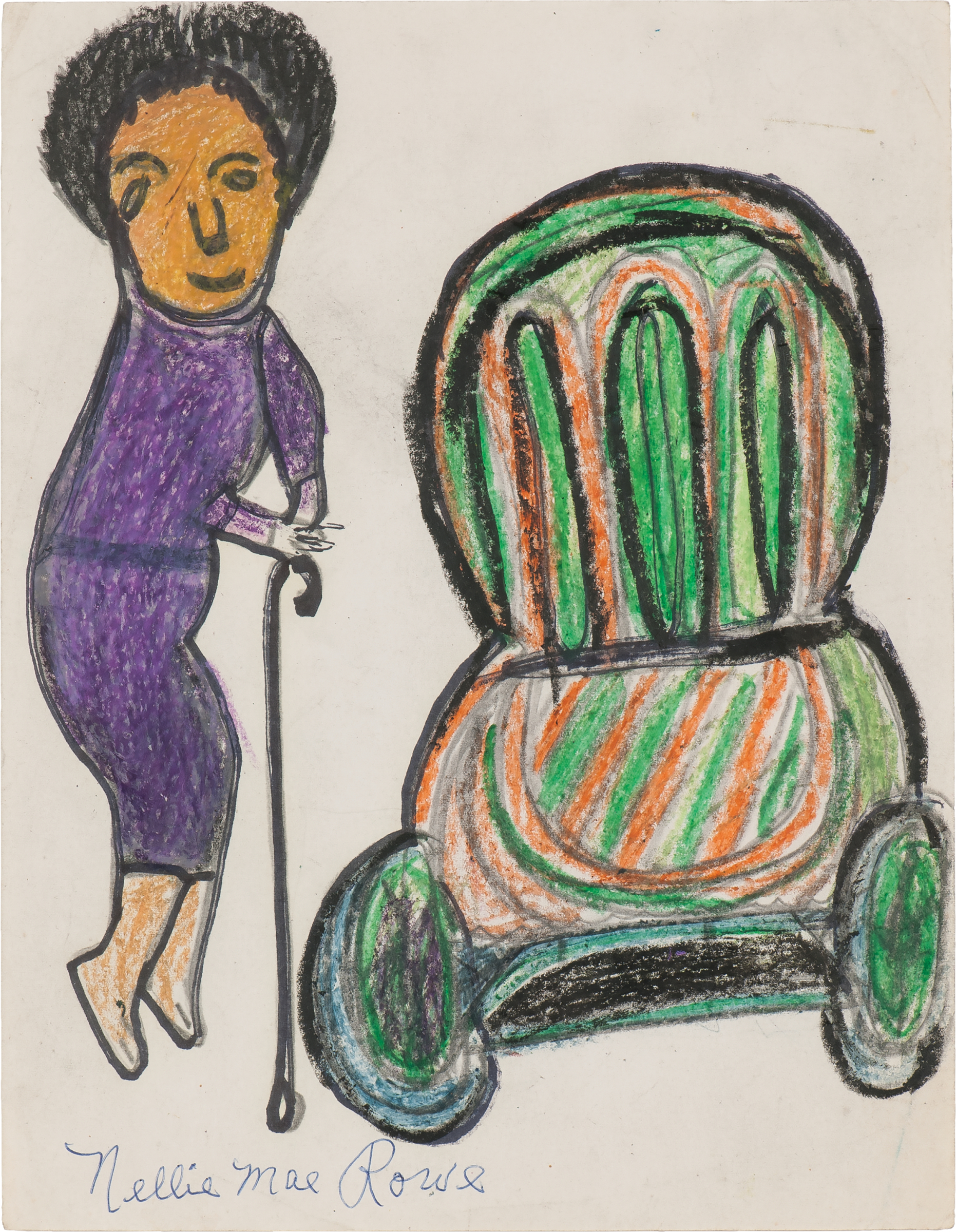
Untitled (Woman in Purple Dress with Green Chair)
Nellie Mae Rowe, American, 1900–1982
1968–1982
Crayon, pencil, and marker on paper
11 x 8 1/2 inches
Gift of Judith Alexander
2003.301 -
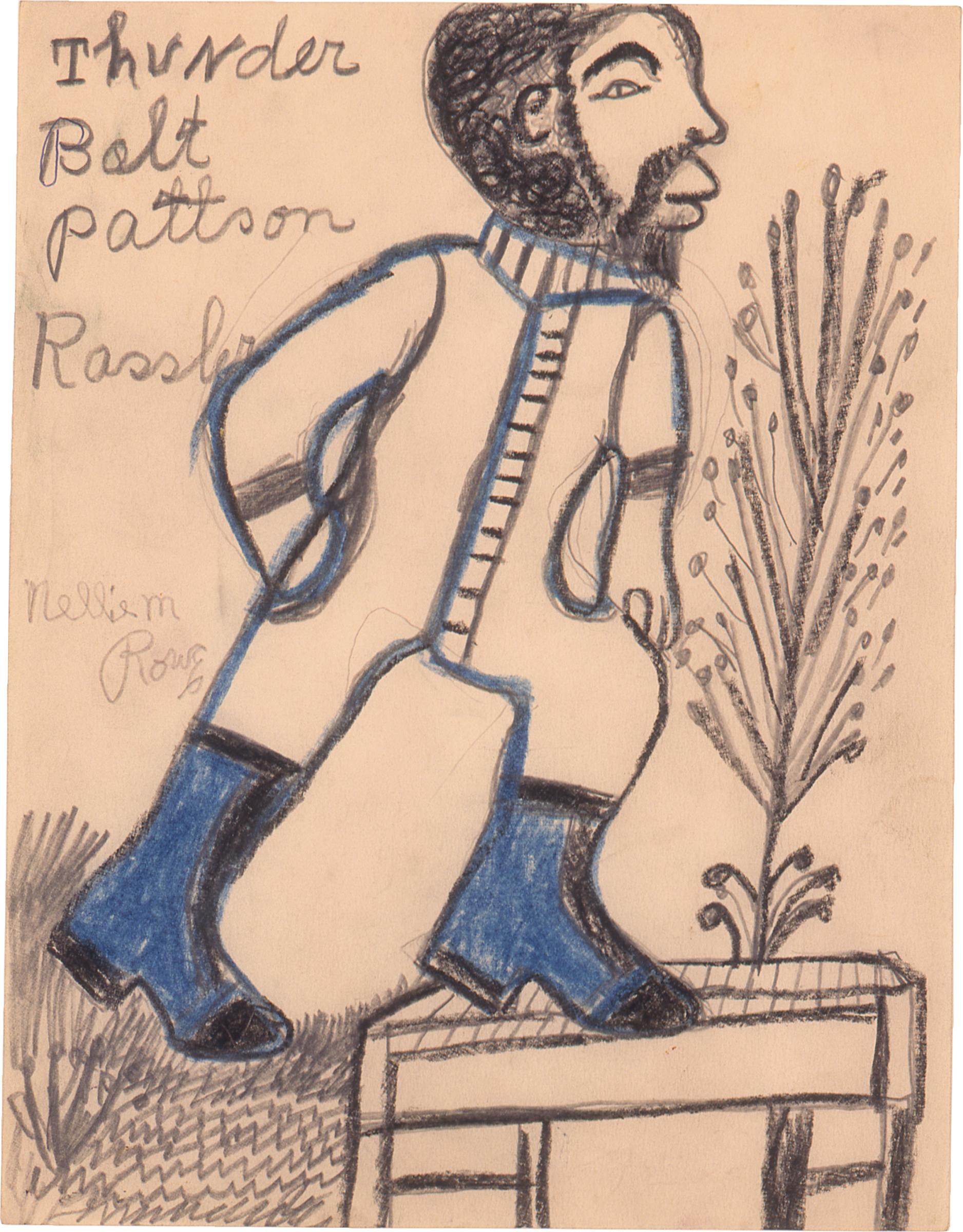
Although Rowe associated art making with childhood, some of her themes were soundly adult. She created several works depicting her favorite athlete, Claude “Thunderbolt” Patterson, and other wrestlers. In one of her wrestling portraits, Patterson shows off his figure in a suggestive pose while looking invitingly at the viewer. Patterson is much more subdued in Untitled (Wrestling Ring), but his female companion (thought to be Rowe herself) leans against him coquettishly. Rowe decorates the base of the ring with a large chicken surrounded by eggs—perhaps a suggestion of the artist’s attraction to Patterson and her reproductive wishes.
Thunder Bolt Pattson Rassler
Nellie Mae Rowe, American, 1900–1982
1968–1982
Crayon and pencil on paper
11 x 8 1/2 inches
Gift of Judith Alexander
2003.225 -
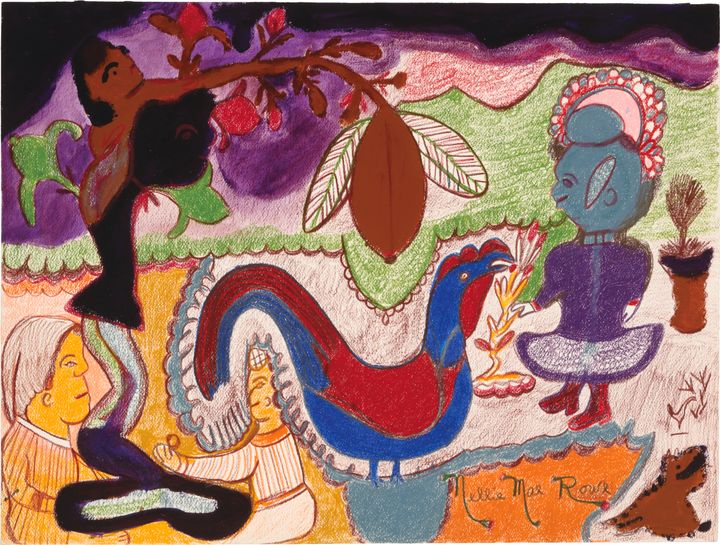
There is a popular belief in some African American communities that dreams of fish precede announcements of pregnancy. The animal’s additional religious connotations of abundance and creation suggest that Rowe’s numerous drawings of fish may have been related to her unfulfilled wish for children. In Untitled (Fish), a large fish is surrounded by flowers budding with breast-like shapes and birds that have a penile appearance. Similarly erotic forms can be found in Untitled (The Hand), along with a rooster, painted a shocking crimson and royal blue, that might also have a coded sexual meaning.
Untitled (The Hand)
Nellie Mae Rowe, American, 1900–1982
1978–1982
Crayon and pencil on paper
18 x 24 inches
Gift of Harvie and Charles Abney
2021.37 -
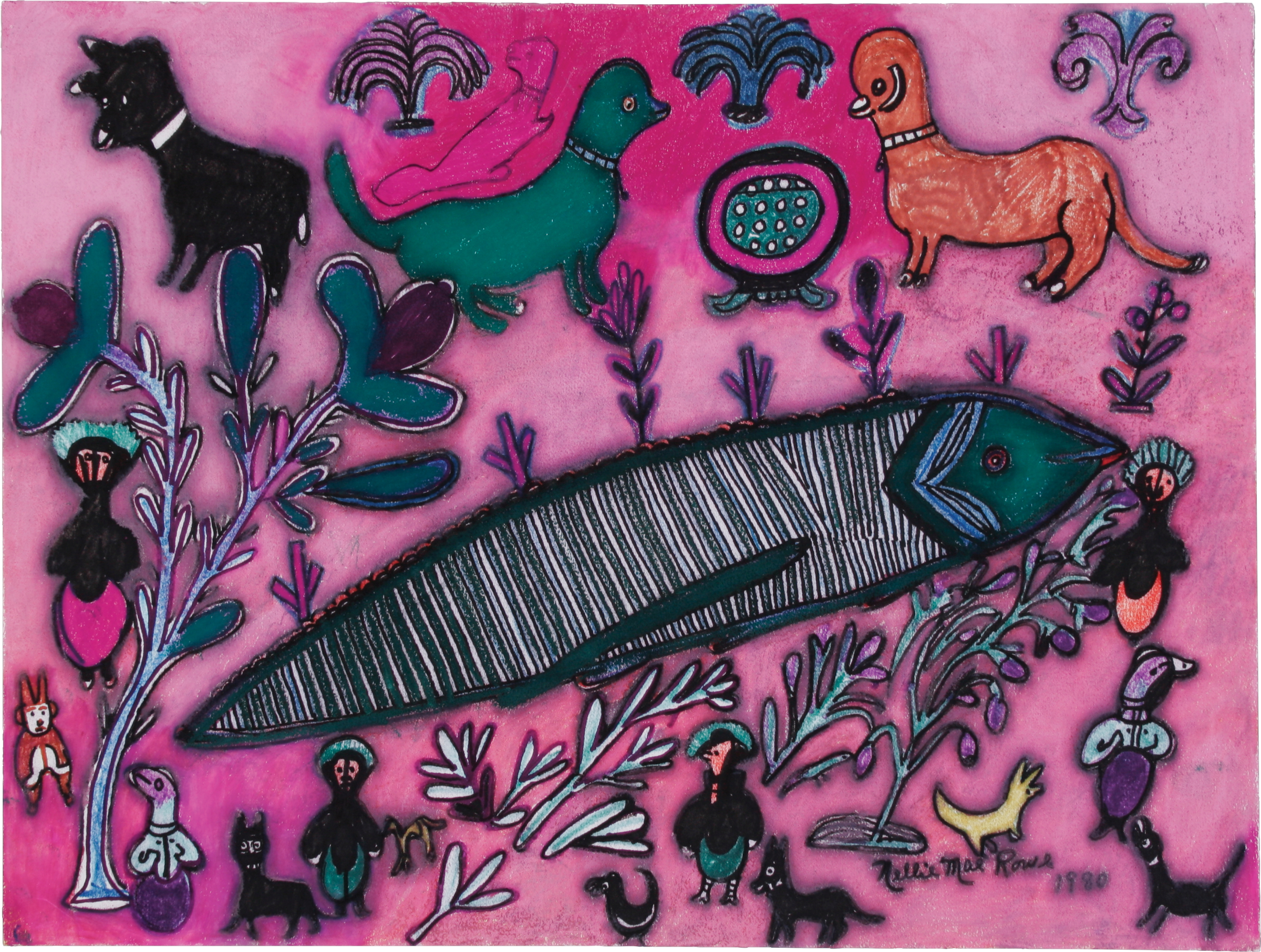
Untitled (Fish)
Nellie Mae Rowe, American, 1900–1982
1980
Crayon, marker, and pencil on paper
18 x 28 7/8 inches
Purchase
1980.79 -
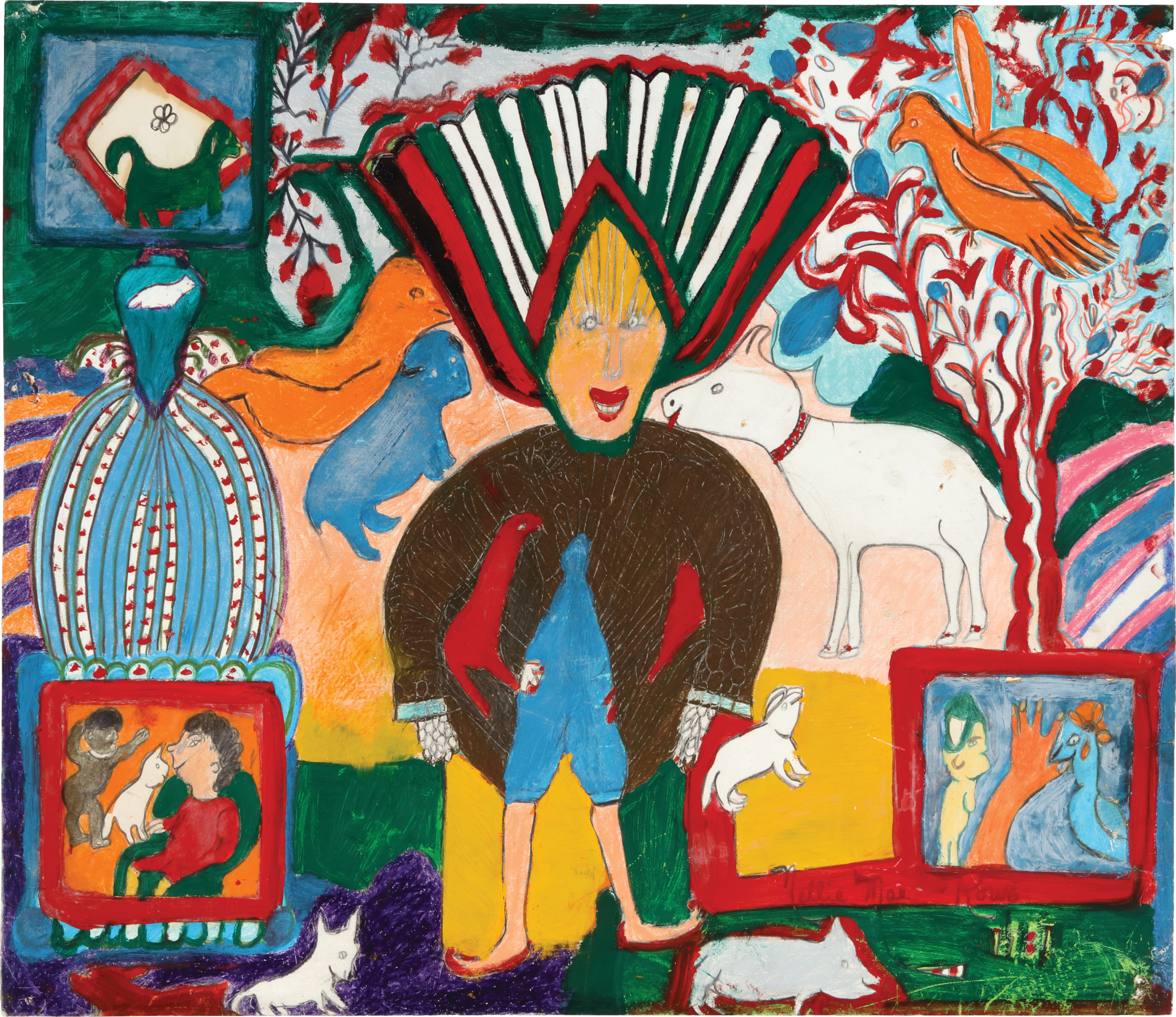
Rowe’s connection with childhood and her longing for children of her own might have played a role in her decision to depict the Atlanta Child Murders—a series of abductions and violent attacks of nearly thirty people (most of them Black children or adolescents) that took place between 1979 and 1981 in Atlanta. As opposed to visually depicting these murders, Rowe addressed the violence in code, using animals and indeterminate vignettes. The figure in the center of the drawing menacingly pulling back a trench-coat-like cape like a flasher may be a more direct reference to the sexual abuse that many of the victims suffered.
Untitled (Atlanta’s Missing Children, Figure with Headdress)
Nellie Mae Rowe, American, 1900–1982
1981
Crayon, gouache, pen, and pencil on paper
24 x 28 inches
Gift of Judith Alexander
2003.213 -
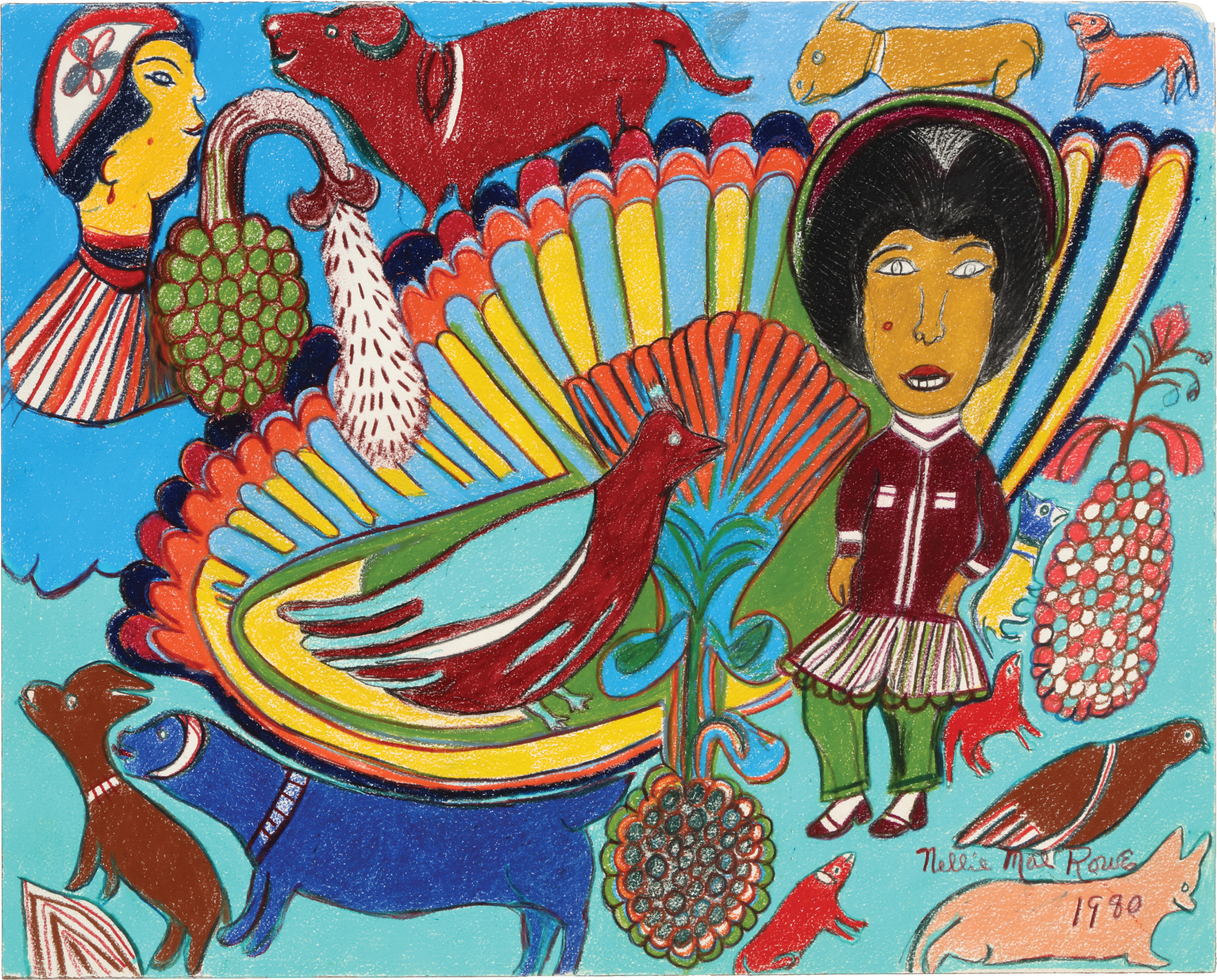
In addition to depicting single feminine figures, Rowe also imaged the interactions between women. With her short haircut, made-up face, and coy expression, the woman in profile seems more mature, while the figure facing forward wears an outfit reminiscent of a school uniform. The singular butterfly wing that alights between them and the sensual form that appears to spray water on it suggest a bath or some kind of rite of passage involving beautification and self-care that may be making the young girl nervous.
Untitled (Woman with Butterfly Wing)
Nellie Mae Rowe, American, 1900–1982
1980
Crayon and marker on paper
16 x 20 inches
Gift of Judith Alexander
2003.210 -
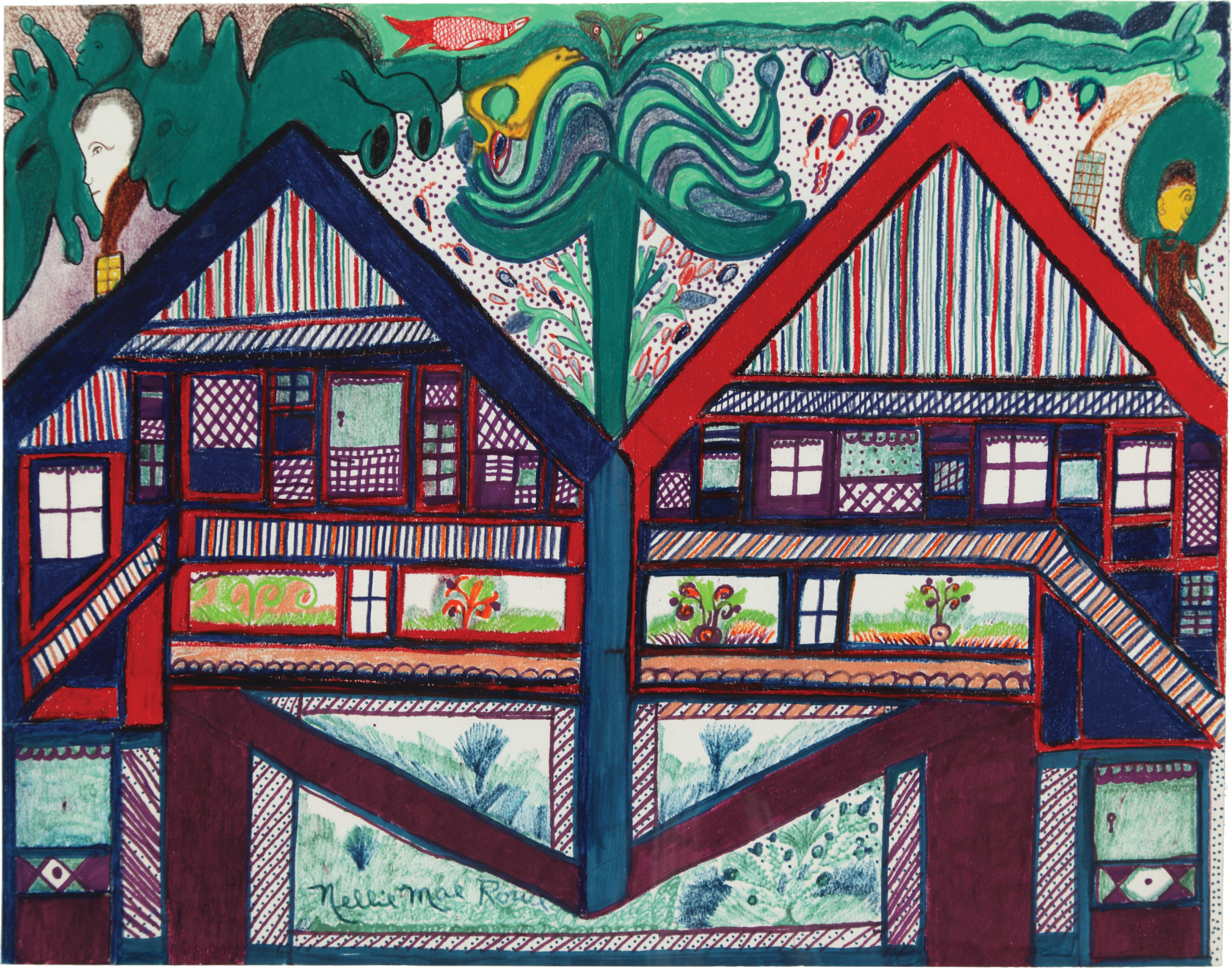
These conjoined houses signify how the destinies of Rowe and her gallerist Judith Alexander were mutually dependent. Alexander had been showing contemporary art for decades, but her close relationship with Rowe led her to become one of the South’s only gallerists dedicated to self-taught artists. The way these houses appear stitched together seemed to inspire the poetic words of Rowe’s great-grandniece Cheryl Mashack at Alexander’s 2005 funeral: “Some of our paths would have never crossed, but there was a plan and a purpose orchestrated from above and thus began the construction of a beautifully made quilt.”
Untitled (Nellie and Judith’s Houses)
Nellie Mae Rowe, American, 1900–1982
1978–1982
Crayon, marker, and pencil on paper
18 1/2 x 23 1/2 inches
Gift of Judith Alexander
2003.209